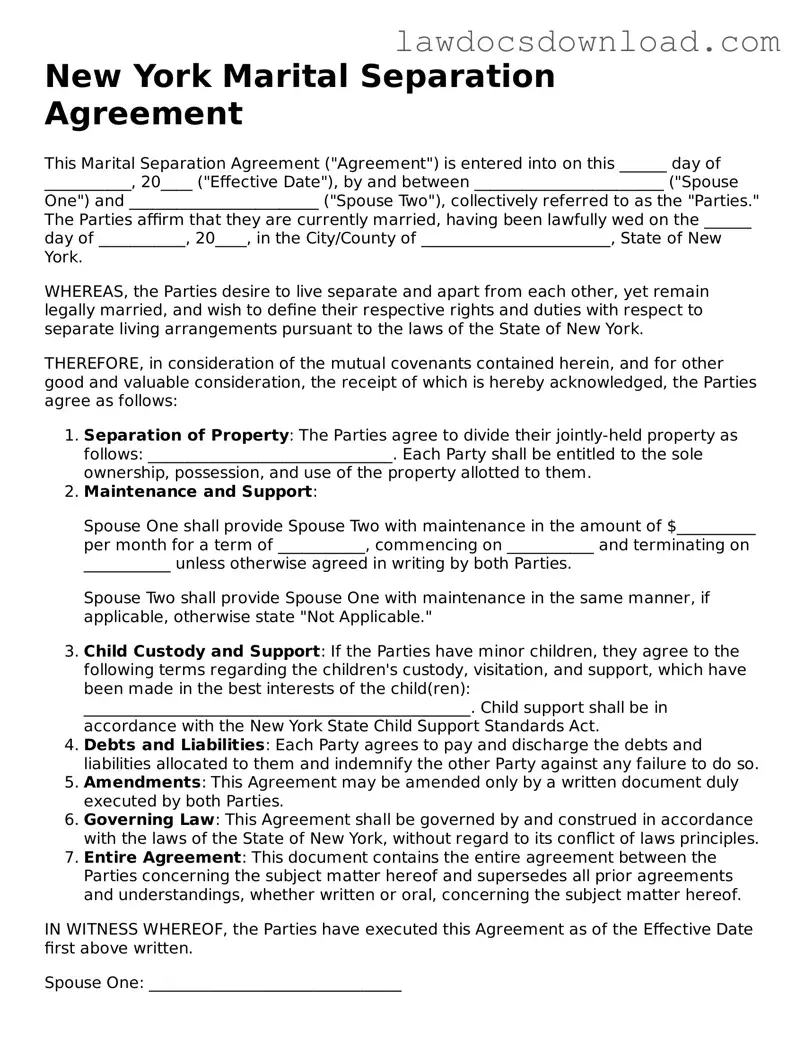Filling out the New York Marital Separation Agreement form is a pivotal step for couples who decide to separate but are not yet ready to divorce. It outlines how assets, debts, child custody, and support will be managed. Unfortunately, many people make errors during this process, which can lead to future legal complications or the need to renegotiate terms.
One common mistake is not fully disclosing financial information. Transparency about one’s financial situation, including income, debts, assets, and liabilities, is crucial. Incomplete or inaccurate financial disclosure can invalidate the agreement or lead to disputes down the line. It's essential for both parties to provide comprehensive financial details to ensure a fair and sustainable agreement.
Another error involves overlooking future needs or changes. Couples often focus on their current circumstances without considering how their financial, health, or child-rearing situations might change. For instance, the need for child support can increase as children grow and their expenses rise. Including provisions for future adjustments can prevent conflicts and the need for court interventions.
Failing to specify custody and visitation schedules in clear, actionable terms is yet another oversight. Ambiguities about when and how each parent will spend time with their children can cause misunderstandings and tension. Detailed schedules, including holidays, school breaks, and special occasions, can help in creating a stable environment for children post-separation.
Many individuals also neglect the need for a dispute resolution mechanism within the agreement. Despite the best intentions, disagreements may arise. Having a pre-agreed method for resolving disputes, such as mediation or arbitration, can save time and money while avoiding the stress of litigation.
A significant error is not reviewing the agreement with a legal professional before signing. While drafting the document without legal help may seem like a cost-saving measure, it can result in an agreement that is not legally sound or enforceable. Legal guidance is invaluable in ensuring the agreement complies with New York laws and truly protects both parties’ interests.
Similarly, neglecting to update wills and estate plans after finalizing a separation agreement is a mistake. The separation agreement might allocate assets differently in the event of death, necessitating changes to estate plans to avoid inconsistencies and ensure intentions are honored.
Rushing through the process without considering all implications is another pitfall. Couples often want to conclude the separation as swiftly as possible, which can lead to poorly thought-out decisions. Taking the time to thoroughly discuss and contemplate each aspect of the agreement can lead to a more equitable and satisfactory arrangement.
Lastly, assuming informal agreements outside the documented terms will be upheld is risky. Verbal agreements or understandings not formally included in the separation document may not be enforceable. It is critical that all agreements are documented and made part of the official separation agreement.
By avoiding these mistakes, individuals can ensure that they create a comprehensive and fair Marital Separation Agreement that stands the test of time and serves both parties' best interests during this transitional phase of their lives.
